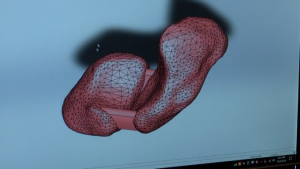Ligament tears are becoming more common in sports. They’re painful and debilitating, and difficult to treat. The current standard is to replace the torn ligament with tendons, but that can cause additional problems down the line.
“What can happen over time is that the tendon itself begins to kind of stretch and become a little bit relaxed in the joint,” said Christina Salas, PhD, a scientist at the University of New Mexico. “Then (the tendon) becomes deficient again.”
 Dr. Salas is currently working on creating 3D printed ligaments, which she says has never been done before. It’s an area of focus she has been working on for some time, with help from students and professors at the University of New Mexico.
Dr. Salas is currently working on creating 3D printed ligaments, which she says has never been done before. It’s an area of focus she has been working on for some time, with help from students and professors at the University of New Mexico.
“This is something that hopefully can reduce some of those failures we see,” said Dustin Richter, Assistant Professor of Sports Medicine and Orthopedic Surgery. “And get people back to doing what they enjoy.”
The researchers have developed a special technique involving electrospinning, which uses electric force to create fibers.
“The near-field electrospinning technique that we have added to the bio-printer actually produces really highly aligned fibers that replicate the ligament tissue,” said Dr. Salas.
Doctors could then take a CT or MRI scan of a patient’s damaged joint and create an exact replica using 3D printing. This could allow for less-invasive surgery, and could be a more permanent solution as the synthetic 3D printed ligament would not wear out or weaken.
“We want to make sure that those patients can truly maintain their full function even longer as they grow older in life,” said Dr. Salas.
The biggest challenge Dr. Salas and her colleagues are facing is figuring out how to attach the 3D printed ligaments to the bone. Dr. Salas recently received a two-year, $150,000 grant for the research.
3D printing is changing the way doctors and scientists look at the treatment of common injuries, such as torn ligaments. Recently, Queensland researchers revealed a new method of 3D printing joint cartilage, which could greatly shorten recovery time after surgery for arthritis and joint injuries – and that’s only one example of the extensive research that is taking place around the world involving the use of 3D printing for the repair of damaged bones and muscles.
Dr. Salas’ research involves artificial ligaments, but other work is taking place that involves 3D printing new tissue using the patient’s own stem cells. Many people automatically jump directly to talking about 3D printing organs when 3D bioprinting is mentioned, but major progress is being made in other areas, like the treatments of degenerative illnesses and common injuries. With 3D printing, athletes have the potential to stay in the game for much longer than they would have otherwise. There may also be less need for things like walkers and wheelchairs as people age, as diseases like arthritis are healed with new cartilage.
When 3D printed organs eventually become realized, they will potentially enable people to live longer than ever before. Until then, bioprinting has the ability to help people live with better quality of life for their natural lifespans.
Discuss this and other 3D printing topics at 3DPrintBoard.com or share your thoughts below.
[Source: KRQE]
Subscribe to Our Email Newsletter
Stay up-to-date on all the latest news from the 3D printing industry and receive information and offers from third party vendors.
Print Services
Upload your 3D Models and get them printed quickly and efficiently.
You May Also Like
Johns Hopkins University Researchers Develop HyFAM Technology
Two scientists from Johns Hopkins University, Nathan C. Brown and Jochen Mueller, have developed a hybrid manufacturing technology they call HyFam, or Hybrid Formative Additive Manufacturing. Their work on this technology...
3D Printing G-Code Gets an Upgrade: T-Code
Good old G-Code still manages many 3D printers, great and small. Just like the STL, it’s a standard that enables collaboration while also holding the additive manufacturing (AM) industry back....
AM Rewind: The Biggest News and Trends of 2024
After a sluggish 2023, driven by persistent inflation and geopolitical tensions, 2024 has seen some recovery. Economic growth climbed from about 2.8 percent in 2023 to a modest 3.2 percent...
Metal Wire 3D Printer OEM ValCUN Announces Plans for 2025 Expansion
ValCUN, a Belgian original equipment manufacturer (OEM) of wire-based metal additive manufacturing (AM) hardware, has announced that the company has entered the next phase of its growth trajectory, making key...



































